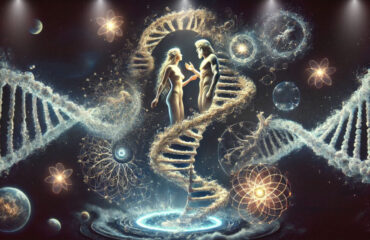
Evolution of Programming
Human beliefs and behaviors have always been shaped by the environments they inhabit and the influences they encounter. Long before the advent of computers, television, and movies – books, oral stories, and gatherings served as the primary mediums for instilling and reinforcing ideas. These “old-school” methods were natural predecessors to the modern platforms that amplify beliefs through algorithms, demonstrating a continuous evolution in how societies are programmed.
Piscean Era
During the Piscean Age, society’s programming revolved around books, texts, and oral traditions. This era was symbolized by learning through community—the “school of fish”—where shared beliefs were passed down by elders, leaders, and religious figures. These authority figures acted as the gatekeepers of collective truth, shaping society’s moral compass through storytelling, scripture, and myth.
Stories shared at gatherings, inscribed on papyrus, or passed down through oral traditions served as powerful tools for reinforcing collective beliefs. These narratives provided a framework for interpreting the world and understanding one’s role within it, fostering a sense of identity and belonging within communities.
Equally significant was the role of symbolism and interpretation in daily life. People found profound meaning in celestial events, natural phenomena, and everyday occurrences. Symbols such as the rising sun, a hawk in flight, or the changing seasons were imbued with cultural significance, reflecting the values, aspirations, and spiritual connections of a society. These interpretations were often deeply personal yet aligned with the broader beliefs of the community, creating a shared sense of purpose and understanding.
The Piscean era was marked by communities relying on confirmation bias to uphold coherence in their shared truths. People naturally gravitated toward stories and narratives that aligned with their existing worldviews, forming an early version of the echo chambers we recognize today. Leaders through spoken words, and authors through written texts played pivotal roles in shaping these truths, guiding individuals toward lives deeply influenced by the external world and its prevailing cultural and societal norms.
Transition to the Age of Aquarius: Free-Flowing Knowledge
As humanity moves into the Age of Aquarius, the mechanisms of programming shift dramatically. This age, symbolized by free-flowing knowledge and technological abundance, brings about the rise of computers, movies, television, and artificial intelligence. Unlike the curated and centralized truths of the Piscean Age, Aquarius opened the floodgates to an overwhelming variety of information sources.
In the Aquarian age, algorithms have replaced elders and leaders as the primary curators of truth. Platforms like social media, search engines, and streaming services analyze user behavior to deliver personalized content. This creates a “reinforcement loop,” where individuals are consistently exposed to information that aligns with their beliefs. Over time, this tailored exposure solidifies their perspectives and limits their openness to alternative viewpoints, just like it did with the leaders during the Piscean Age.
Similar to traditional societies confined by cultural echo chambers, algorithms further narrow perspectives by filtering out contradictory ideas. This restricted exposure fosters polarization, as individuals become surrounded by like-minded thoughts and ideologies. This environment reinforces their sense of “rightness,” making them less likely to engage with differing perspectives.
The repetition of content, whether through books in earlier eras or modern digital platforms, contributes to one’s sense of consensus. People begin to believe their truths are universal, assuming widespread agreement where it may not exist within the truths of anything external outside of themselves. This perception fuels competition, expansion and individualism as people strive to prove others wrong and assert their own perspectives as the definitive truth.
The Natural Programming of Beliefs
Despite changes in medium—from papyrus scrolls to digital feeds—the underlying mechanisms of belief programming remain constant. Humans are naturally predisposed to seek patterns, construct narratives, and reinforce their worldview. The human mind acts as its own algorithm, constantly filtering experiences and perceptions based on past emotions, memories, and deeply held values. This internal narrative shapes how individuals interpret the world around them, guiding their reactions and decisions in a way that reinforces their existing beliefs and emotional states.
Symbols and their relevance play a significant role in this process. Whether it’s a story heard from a friend or a sign observed in nature, people naturally assign meaning to their environment that aligns with their worldview. These interpretations, often personal yet culturally influenced, allow individuals to make sense of their surroundings in ways that feel deeply resonant.
Before the advent of modern technology, communities themselves functioned as echo chambers, with traditions, norms, and shared values reinforcing collective truths. In today’s world, algorithms have amplified these tendencies, creating digital spaces that replicate and intensify the same dynamic. Through both natural and technological means, humanity continues to seek and reinforce patterns that resonate with their cultural and individual identities.
Divine Oversight: The Role of God and Astrology
Ultimately, whether through ancient storytelling or modern algorithms, all programming flows through a divine framework. God, acting as the ultimate source of order, uses the tools of each era to guide humanity’s evolution. During the Piscean Age, this manifested through learning and text. In the Age of Aquarius, it manifests through the abundance of knowledge and technology.
Astrology provides insight into this divine programming, with each age bringing its own methods of shaping human consciousness:
The Age of Pisces was a focus on introspection, learning, and spiritual connection through written and oral traditions. Papyrus, paper and books were the leaders of influence. But now the Age of Aquarius moves towards a proliferation of knowledge, innovation, and free-flowing information through machines, A.I., and digital platforms.
Conclusion
The progression from books and stories to algorithms and A.I. demonstrates the evolving methods by which society programs itself. While the mediums change, the essence of belief reinforcement remains rooted in human psychology, cultural traditions, and divine intention.
The Age of Pisces was characterized by a more deliberate and controlled approach to teaching, learning, and sharing knowledge. During this time, influence was centralized and often required significant effort to access. Written materials, such as those on papyrus or early paper, were precious and labor-intensive to produce. Writing or printing took time, resources, and skill, which made such texts less widely available. This scarcity inherently limited the spread of information and ensured that only select teachings or truths were disseminated, often under the careful control of leaders, scholars, or religious figures. This was Limited access.
Learning in this age required physical presence and active participation. To be influenced by a preacher, teacher, or leader, one had to set aside time to travel to a church, temple, or other gathering place. The process of acquiring knowledge or being exposed to new ideas was slow and deliberate, fostering a deep sense of introspection and connection to the material. Education and spiritual growth were steeped in tradition, and knowledge was seen as something earned through patience, effort, and discipline.
In contrast, the Age of Aquarius has ushered in a revolutionary shift toward instant access to information. Digital platforms, artificial intelligence, and the internet have removed many of the barriers that once limited the spread of knowledge. Audio books, podcasts, and online videos cater to a world with an average 7th-grade reading level, making learning more accessible to diverse audiences. With a smartphone or computer, anyone can access vast amounts of information at any time, eliminating the need for physical travel or extended waiting periods. This is Unlimited access.
Truth and influence in the Aquarian Age no longer require direct interaction with a leader or teacher. Virtual platforms provide instant access to sermons, lectures, and teachings from across the globe, all without leaving home. The internet has become the ultimate repository of free-flowing knowledge, where ideas proliferate at an unprecedented pace. This abundance of information encourages exploration and innovation, but it also presents challenges, such as navigating misinformation and information overload.
The divine operates seamlessly through all ages, transcending the mediums through which humanity is educated and influenced. Whether through the written texts and oral traditions of the Age of Pisces or the digital platforms and instantaneous knowledge of the Age of Aquarius, the divine works to guide human consciousness toward growth and evolution. Each medium serves as a vessel for divine wisdom, adapted to the needs and capacities of the time. In every interaction, whether through a preacher’s sermon, a book’s pages, or an online video, the divine sparks inspiration, self-discovery, and collective progress. No matter the tools or methods, the divine flows through every moment, shaping our understanding and awakening us to higher truths.



